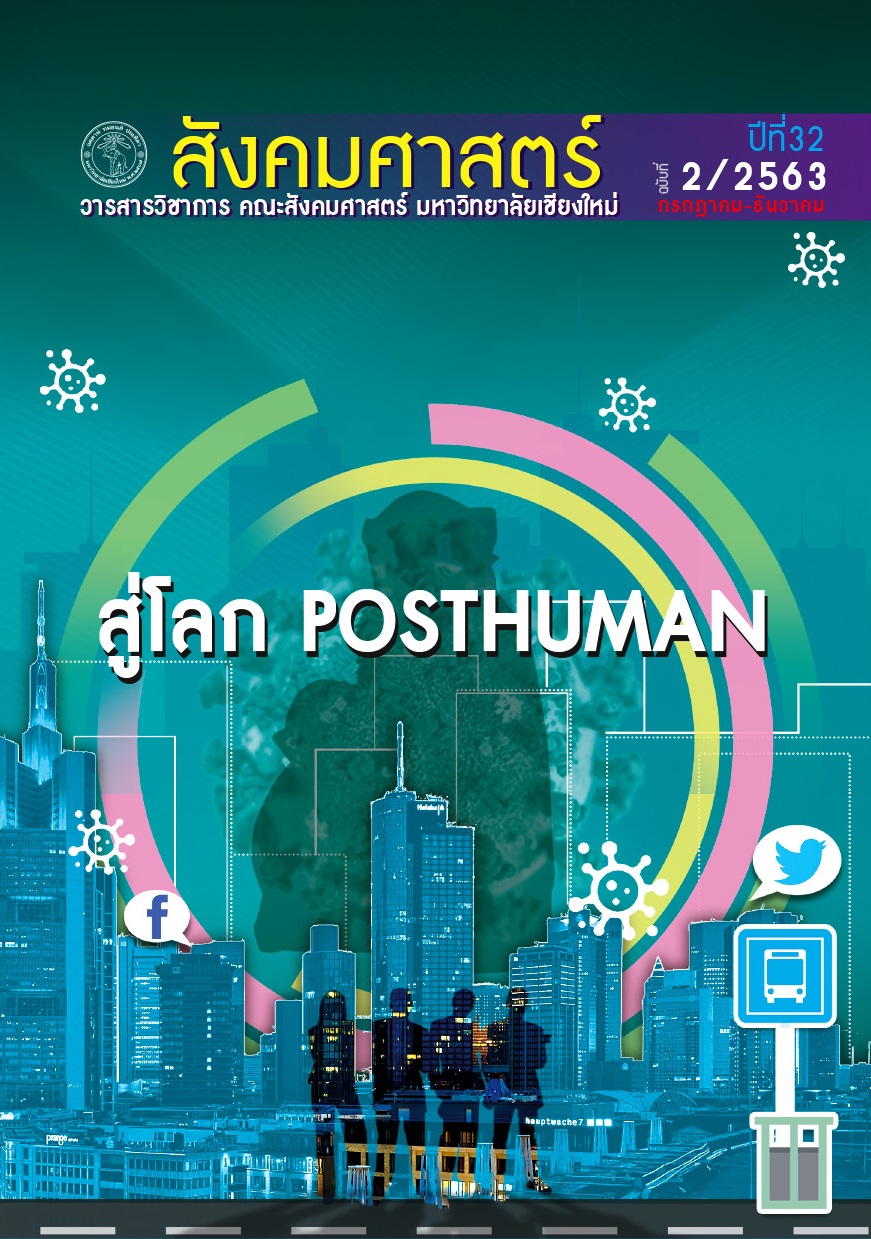Line of life between macaques and the macaque caretakers: towards posthuman spaces of dwelling and becoming
Main Article Content
Abstract
This article presents the story between macaque and Por the macaque caretaker from Chomporn province who trained his monkeys to harvest coconut for career over fifty years ago. When tourism boomed, Por travelled to Phuket to start “monkey show” for Chinese tourists, then journeyed to Mae Rim, Chiang Mai to set up his “Monkey training center”. From the perspective of posthuman geographies, this article focuses on the vitality and animality that materialized along the voyage from the South to the North, and from coconut plantations to performing stages. The macaque were not mere working animals for entertainment in nature tourism. Because of their uniqueness and ability that draw in other living things and stuffs into relations, Spaces of fluidity and becoming emerge. At the training center, a place where matter out of place were performed to attract tourists, reveals the becoming of show monkey and the becoming of monkey caretaker that were forged from learning each other’s body languages, making noises and making eyes, including perceiving the rope tension from pulling or twitching. Moreover, due to the act and show equipment, physiological and behavioral development of the macaques in Chiang Mai were significantly different from those in Chumporn. At the same time, the caretaker grew into entrepreneurship that constantly adapt to survive under the power of neoliberalism of nature.
Article Details
All written articles published on Journal of Social Sciences is its author’s opinion which is not belonged to Faculty of Social Sciences, Chiang Mai University or is not in a responsibility of the journal’s editorial committee’s members.
References
กมเลศ โพธิกนิษฐ, พัชรินทร์ สิรสุนทร และ วัชรพล พุทธรักษา. 2560. “แรงงานข้ามชาติกับการทำให้เป็น “สัตว์-เศรษฐกิจ” ภายใต้ภาวะการถูกกดทับ: กรณีศึกษาแรงงานข้ามชาติในประเทศไทย.” วารสารสังคมศาสตร์ มหาวิทยาลัยนเรศวร. 13 (2): 99-119.
เก่งกิจ กิติเรียงลาภ. 2560. PERSPECTIVE: ภววิทยาแบบมุมมองนิยมและความเป็นซับเจค. เชียงใหม่: TURN.
จันทนี เจริญศรี. 2559. ศาสตร์ อศาสตร์: เข้ามาข้างนอก ออกไปข้างใน. นนทบุรี: ภาพพิมพ์.
ชยา วรรธนะภูติ และ รัตนาภรณ์ พุ่มน้อย. 2561. ““โลกพันทาง” ของลุ่มน้ำ ปลาและผู้คนแห่งบ้านกง อำเภอกงไกรลาศ จังหวัดสุโขทัย: มุมมองเชิงภูมิศาสตร์มนุษย์.” วารสารสังคมวิทยาและมานุษยวิทยา มหาวิทยาลัยธรรมศาสตร์. 37 (2): 125 - 156.
ชัยยศ ยงค์เจริญชัย. 2563. “การใช้ลิงขึ้นมะพร้าว ภูมิปัญญาตามวิถีชาวบ้านหรือการทรมานสัตว์.” BBC. 15 กันยายน 2563. https://www.bbc.com/thai/thailand-53763690
พนา กันธา. 2562. “พหุภววิทยาในโลกคู่ขนานระหว่างสัตว์กับมนุษย์.” วารสารสังคมศาสตร์ มหาวิทยาลัยนเรศวร. 13 (2): 5-24
จักรกริช สังขมณี. 2559. “ความไม่(เคย)เป็นสมัยใหม่ของศาสตร์-อศาสตร์: อวัตถุวิสัย อมนุษยนิยม และเครือข่าย-ผู้กระทำของบรูโน ลาตูร์.” ใน ศาสตร์ อศาสตร์: เข้ามาข้างนอก ออกไปข้างใน, บรรณาธิการโดย จันทนี เจริญศรี, 142-67. นนทบุรี: ภาพพิมพ์.
สุดแดน วิสุทธิลักษณ์. 2560. สิงสาราสัตว์ : มานุษยวิทยาว่าด้วยสัตว์และสัตว์ศึกษา. กรุงเทพ: คบไฟ.
สุรเดช โชติอุดมพันธ์. 2560. “สัตว์ศึกษา: โลกหลังภาพแทน.” ใน สิงสาราสัตว์ : มานุษยวิทยาว่าด้วยสัตว์และสัตว์ศึกษา, บรรณาธิการโดย สุดแดน วิสุทธิลักษณ์. 201-233. กรุงเทพ: คบไฟ.
Barua, Maan. 2014. “Circulating Elephants: Unpacking the Geographies of a Cosmopolitan Animal” Transactions of the Institute of British Geographers 39 (4): 559-573
Callon, Michel. 1986. “Some Elements of a Sociology of Translation: Domestication of the Scallops and the Fishermen of St Brieuc Bay.” In Power, Action and Belief: a new Sociology of Knowledge?, edited by John Law, 196-233. London: Routledge & Kegan Paul.
Country, Bawaka, S. Wright, S. Suchet-Pearson, K. Lloyd, L. Burarrwanga, R. Ganambarr, M. Ganambarr-Stubbs, B. Ganambarr, and D. Maymuru. 2015. “Working With and Llearning from Country: Decentring Human Authority.” Cultural Geographies 22: 269-283.
Duffy, Rosaline and Lorraine. Moore. 2010. “Neoliberalising Nature? Elephant-Back Tourism in Thailand and Botswana.” Antipode 42 (3): 742-766.
Emel, J., C. Wilbert, and J. Wolch. 2002. “Animal Geographies.” Society & Animals 10 (4): 407-412.
Fuentes, Agustin. 2013. “Pets, Property, and Partners: Macaques as Commodities in the Human-Other Primate Interface.” In The Macaque Connection: Cooperation and Conflict between Humans and Macaques, edited by Sindhu Radhakrishna, Michael A.Huffman, and Anindya Sinha, 107-126. London: Springer.
Haraway, Donna. 2008. When species meet. Minneapolis: University of Minnesota Press.
Hinchliffe, Steve, Matthew B. Kearnes, Monica Degen, and Sarah Whatmore. 2005. "Urban Wild Things: A Cosmopolitical Experiment." Environment and Planning D: Society and Space 23: 643-658.
Ingold, Tim. 2000. The Perception of the Environment: Essays on Livelihood, Dwelling and Skill. London: Routledge.
Ingold, Tim. 2011. Being alive: essays on movement, knowledge and description. London: Routledge.
Ingold, Tim. 2015. The life of lines. London: Routledge.
Jones, Owain. 2003. “‘The restraint of Beasts’: Rurality, Animality, Actor Network Theory and Dwelling.” In Country Visions, edited by Paul Cloke, 283-303. Essex: Pearson.
Johnston, C. 2008. “Beyond the clearing: towards a dwelt animal geography.” Progress in Human Geography 32 (5): 633-649.
Sponsel, Leslie E, Poranee Natadecha-Sponsel and Nukul Ruttanadakul. 2004. “Coconut-picking Macaques in Southern Thailand: Economic, Cultural and Ecological Aspects.” In. Wildlife in Asia: Cultural perspective. Edited by John Knight, 112-128. London: Routledge.
Whatmore, Sarah. 2002. Hybrid Geographies: Natures, Cultures, Spaces. London: SAGE.
Whatmore, Sarah. 2006. "Materialist Returns: Practising Cultural Geography in and for a more-than-Human World." Cultural Geographies 13: 600-609.


